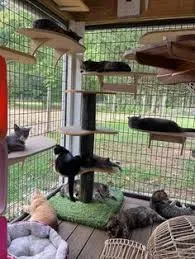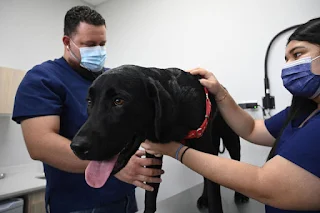
Why exactly do our furry friends need both physical exercise and mental stimulation? The answer lies in their overall well-being. Just like humans, pets thrive when their physical and mental needs are met.
- Physical Health: Regular exercise helps pets maintain a healthy weight, strengthens their muscles, and improves cardiovascular health. It's especially important for high-energy breeds that require more activity to stay fit and happy.
- Mental Health: Mental stimulation keeps their minds sharp. Activities that challenge their brains help prevent cognitive decline, especially in older pets. It’s like a workout for their brain!
- Behavioral Benefits: A well-exercised and mentally stimulated pet is a well-behaved pet. Many common behavioral issues, like excessive barking or chewing in dogs, or scratching and aggression in cats, stem from boredom and excess energy. Keeping them engaged reduces these problems significantly.
- Emotional Well-being: Regular play and interaction foster a deeper bond between pets and their owners. It’s not just about keeping them busy; it’s about nurturing a loving and understanding relationship.
Prevention of Health Issues:

So, let’s get moving and thinking with our four-legged companions! Now, let's look at how to recognize if your pet needs more exercise and mental stimulation.

It's vital to recognize when our pets are not getting enough exercise or mental stimulation. Here are some key signs to look out for in both dogs and cats:
- Restlessness and Destructive Behavior: Is your dog digging up the garden more than usual? Is your cat scratching furniture relentlessly? These behaviors often indicate pent-up energy and boredom.
- Excessive Barking or Meowing: While some vocalization is normal, excessive noise can be a cry for more interaction and activity.
- Lethargy or Depression: Just like humans, pets can get the blues. A lack of physical activity and mental engagement can lead to a noticeable drop in energy and enthusiasm.
- Overeating or Lack of Appetite: Changes in eating habits can be a sign of emotional distress due to insufficient stimulation.
- Sleeping More Than Usual: While cats naturally sleep a lot, too much sleep in dogs or a significant increase in your cat's sleeping habits could be a sign of boredom.
- Obsessive Behaviors: Over-grooming in cats or obsessive tail-chasing in dogs can be a response to lack of mental engagement.
Recognizing these signs is the first step towards providing a healthier, happier life for your pets. Next, we'll explore fun and effective ways to exercise both dogs and cats.

Keeping your pet physically active is not just essential for their health, but it can also be a lot of fun! Let's explore some engaging exercise ideas for both dogs and cats:
For Dogs:
- Walks and Runs: The classic walk is always a winner. Vary your routes to keep it interesting. For more active breeds, consider jogging or running.
- Fetch: It’s a great way to get your dog moving, plus it strengthens your bond.
- Tug-of-War: A fantastic way to engage their muscles and satisfy their play instincts.
- Agility Training: Set up a mini obstacle course in your backyard for a fun challenge.
- Swimming: If your dog enjoys water, swimming is an excellent, low-impact exercise.
For Cats:
- Feather Wands and Laser Pointers: These toys stimulate their hunting instincts and get them leaping and pouncing.
- Interactive Toys: Puzzle toys and treat-dispensing gadgets provide both physical activity and mental stimulation.
- Cat Trees and Climbing Shelves: These not only encourage climbing and jumping but also cater to their love for high vantage points.
- Hide and Seek with Treats: Hiding treats around the house encourages exploration and exercise.
- Playtime with You: Engaging directly with your cat, whether it’s through a game of chase or using simple toys like strings or balls, is invaluable.
Remember, the key is to find activities that both you and your pet enjoy. This not only ensures they get the exercise they need but also strengthens the bond you share with them. Up next, we'll look into mental stimulation techniques for your furry companions.

Just as our bodies need exercise, our pets' minds need challenges to stay sharp and engaged. Here are some creative ways to provide mental stimulation for both dogs and cats:
For Dogs:
- Puzzle Toys: These toys make your dog work a little for their treats, stimulating their brain in the process.
- Obedience Training: Regular training sessions challenge your dog's mind. Learning new commands or tricks keeps them mentally sharp.
- Interactive Games: Games like hide-and-seek or find-the-treat engage your dog's senses and problem-solving skills.
- New Experiences: Regularly introducing your dog to new environments, smells, and sights can provide mental stimulation.
- Socialization: Playdates with other dogs encourage social skills and mental engagement.
For Cats:
- Interactive Cat Toys: Toys that mimic the movement of prey, like a laser pointer or a feather wand, stimulate your cat's natural hunting instincts.
- Food Puzzles: These can be store-bought or homemade and encourage your cat to think creatively to access treats.
- Training Sessions: Yes, cats can be trained too! Teaching them tricks or commands can be a fun way to challenge their minds.
- Exploration Opportunities: Allowing your cat safe access to explore new areas, like a secured balcony or a new room, can be mentally stimulating.
- Regular Playtime: Engaging directly with your cat in play can stimulate their mind and strengthen your bond.
Remember, mental stimulation is just as important as physical exercise for your pet's overall health. A mentally engaged pet is a happy and healthy one!

As we wrap up our journey into the world of pet exercise and mental stimulation, it’s clear that these aspects play a vital role in the overall happiness and health of our pets. By incorporating a mix of physical activities and mental challenges into their daily routines, we not only ensure that our pets are physically fit and mentally sharp but also deepen the bond we share with them.
Remember, a tired pet is a happy pet, and a stimulated pet is an engaged and well-behaved companion. So, take the time to explore different activities with your furry friend, and watch as they flourish into well-rounded and content members of your family.
We hope this guide has inspired you to get creative with your pet's exercise and mental enrichment. Share your experiences and tips in the comments below – we'd love to hear how you keep your pets active and engaged!




.jpg)







































